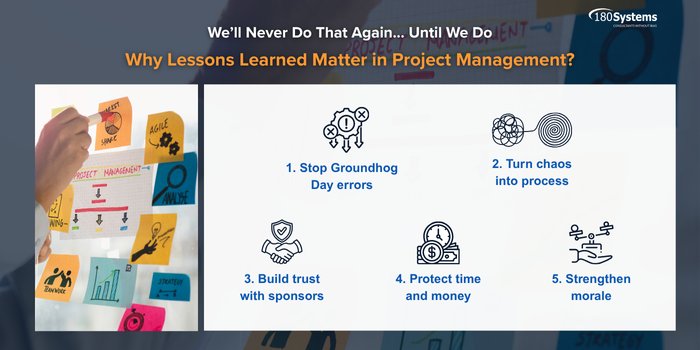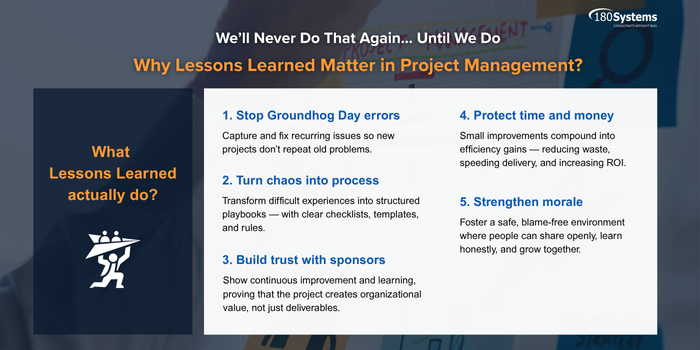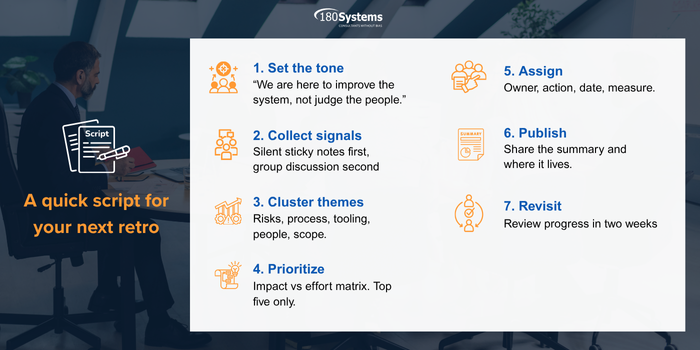There are two kinds of project teams.
- The ones who swear, “We’ll never do that again,” and then do exactly that again.
- The ones who run lessons learned and actually change how they work.
Only one of these teams finishes with fewer scars and more cake.
Lessons learned are the unglamorous secret sauce of project management. They are part detective work, part therapy, part continuous improvement. And yes, they can be funny, because if we cannot laugh at the time we deployed to production on a Friday, we might cry.
The serious bit: what lessons learned actually do
1) Stop Groundhog Day errors
Without a retro, the same avoidable mistakes return like a boomerang with better aim. Lessons learned create a documented memory so new projects do not repeat old “adventures.” That vendor who ghosted you for two weeks? That test plan with 17 owners and zero accountability? Capture it, fix it, and stop the loop.
2) Turn chaos into process
Lessons learned convert “That was rough” into “Here is a playbook.” You move from improvisation to orchestration. The team gains checklists, templates, and decision rules that shorten timelines and reduce risk. You also save future-you from deciphering mysterious files named Final_v7_REALLYFINAL.xlsx.
3) Build trust with sponsors
Executives do not expect perfection. They expect progress. Showing a clear loop from insight to action says, “Your budget did not just buy deliverables. It bought a smarter organization.” That earns you permission to try bolder ideas next time.
4) Protect time and money
Small fixes compound. The 30 minutes saved per sprint on handoffs, the two days shaved off testing by using a data generator, the fourth status meeting replaced with a dashboard. Lessons learned turn friction into efficiency and efficiency into dollars.
5) Strengthen morale
A good retro is blameless and curious. People are more willing to surface problems when they know the outcome is improvement, not finger-pointing. Psychological safety grows, and so does honest signal from the team. Honest signal is gold.
The funny bit: greatest hits you can actually fix
- “The Invite that Ate the Afternoon” – A calendar invite with 25 people and no agenda. Fix: every meeting needs a purpose, inputs, outputs, and a decision owner. Put it in the template and enforce it.
- “Attachment Olympics” – Six versions of the deck fighting for attention. Fix: one source of truth in a shared location with naming conventions and version control. Also, ban “final” from filenames.
- “Friday Deploy” – Because weekends are for hotfixes, apparently. Fix: a release calendar that avoids high-risk windows, with rollback plans tested, not imagined.
- “Stakeholder Peekaboo” – The VP appears in week 12 with brand new requirements. Fix: stakeholder map, RACI, and a cadence that keeps decision makers visible and accountable.
How to run lessons learned without putting people to sleep – Do it early and often
Waiting until the end of a long project is like doing a fire drill after the building has burned down. Run mini-retros at key milestones. Keep the final one short because you have been learning all along.
Set ground rules
Blame-free. Specific, not vague. Actionable, not philosophical. Tackle “what” and “how,” not “who.” If you need a scapegoat, blame entropy.
Use a lightweight structure
Try three prompts:
- What should we keep?
- What should we change?
- What should we stop?
Then ask the magic follow-up: “What evidence do we have?”
Turn insights into owners, not orphans
Every lesson needs a clear action, an owner, a due date, and a definition of done. Put them in your backlog or improvement log. If it is not tracked, it will be forgotten by Tuesday.
Store them where humans can find them
Central repository, searchable tags, and a short readme. Link lessons to templates and checklists. When someone starts a similar project, they should discover the wisdom before they rediscover the problem.
Close the loop
At project kickoff, review the top five relevant lessons from similar projects. This is the moment that transforms “a nice document” into “a better outcome.”
A quick script for your next retro
- Set the tone: “We are here to improve the system, not judge the people.”
- Collect signals: Silent sticky notes first, group discussion second.
- Cluster themes: Risks, process, tooling, people, scope.
- Prioritize: Impact vs effort matrix. Top five only.
- Assign: Owner, action, date, measure.
- Publish: Share the summary and where it lives.
- Revisit: Review progress in two weeks.
The payoff
Projects are a conveyor belt of unknowns. Lessons learned tilt the odds in your favor. They shrink risk, speed delivery, and grow credibility. They also make the team funnier, because nothing beats telling the story of “Friday Deploy” as a legend from the past, not a preview of the weekend.
Run your retro. Capture the lessons. Give future-you a high five.



Only 2 kinds of project teams…so true.
Love it! Great article.